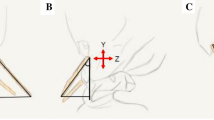Abstract
Eagle’s syndrome is one of the commonly overlooked cause of foreign body sensation in throat with referred otalgia. Incidence of symptomatic cases was rare. Elongated Styloid process may present with myriad symptoms. The diagnosis needs a cautious approach and the management is mainly aimed at reduction of the length of elongated section. Prospective study in the Department of ENT Stanley Medical College, Chennai. Study period-January 2018 to September 2018. Clinical examination followed by radiological investigations done to confirm the diagnosis. Stylo-tonsillectomy was done in the selected 20 subjects and post-operative outcomes were compared with pre-operative questionnaires. The progression of symptoms were evaluated for resolution and studied. Pharyngeal symptoms are more common. The length of styloid is associated with symptom complex presentation. The incidence was 0.17% in general population coming to ENT OPD and more common among women with mean age of 43 years. Bilateral presentation was more common and the longest length recorded in the study was 78 mm. Single investigation is not enough to confirm the diagnosis. A minimum of two investigations are needed for planning surgical management. Intra-oral approach with stylo-tonsillectomy was done with no major complications in post-operative period. Pre-operative symptoms were recoreded by use of McGill’s pain questionnaire and compared with post-operative scores. Dysphagia was the major post-operative early symptom which took a week minimum to subside. Clinical findings and atleast 2 imaging studies needed for diagnosis of the disorder. OPG though economical can be aided to great extent by use of Conebeam CT or 3D CT to study the elongated styloid process. Stylo-tonsillectomy is a safer approach with minimum complications and earlier relief of pre-operative symptoms. Surgical management with reduction of length of elongated styloid followed by adequate analgesia remains mainstay in treatment.








Similar content being viewed by others
References
Philip DY, Otalgia (2018) In: Watkinson JC et al. Scott-Brown’s otorhinolaryngology head and neck surgery, volume 3 8th edn, p 1145
Eagle WW (1937) Elongated styloid process: report of two cases. Arch Otolaryngol 25:584–586
Steinmann EP (1968) Styloid syndrome in absence of an elongated process. Acta Otolaryngol 66:347–356
Divyadharshini, Jayanth Kumar V (2016) Assessment of styloid process length in orthopantomogram—a radiographic study. Int J Pharm Bio Sci 7(4): 503–506
Kumar M, Shanavas M, Sidappa A, Kiran M (2015) Cone beam computed tomography—know its secrets. J Int Oral Health 7(2):64–68
Huang C-C, Tsai Y-H, Liao Y-S, Weng H-H, Yang B-Y (2006) Three-dimensional reconstruction CT in diagnosis of Eagle’s syndrome: a retrospective study. Chin J Radiol 31:221–225
Sebastijan S, Klara S (2000) Styloid process syndrome. Actastomatolcroat 34(4):451–456
Prasad KC et al (2002) Elongated styloid process (Eagle’s syndrome): A clinical study. J Oral Maxillofac Surg 60(2):171–175
Donmez M, Okumus O, Pekiner FN (2017) Cone beam computed tomographic evaluation of styloid process: a retrospective study of 1000 patients. Eur J Dent 11:210–215
Raja SK et al (2018) Active surgical management of pharyngodynia in cases attributable to styloid complex. Int J Appl Res 4(3):319–323
Salam RTA (2017) A clinical analysis of Eagle’s syndrome by its clinical features and therapeutic response to surgical treatment. Int J Sci Stud 5(10):97–104
Nayak DR, Pujary K, Aggarwal M, Punnoose SE, Vachaly (2007) Role of three-dimensional computed tomography reconstruction in the management of elongated styloid process: a preliminary study. J Laryngol Otol 121:349–353.
Acknowledgements
The corresponding author wishes to acknowledge the ever supportive teaching faculty of the institution where the study was conducted; Dr. K. Athiyaman, Dr. P. Chozhan and Dr. V. Saravanaselvan without whom surgical treatment of the population studied would not have been accomplished and the faculty of Government Dental College and Hospital, Chennai and the radiologists of Government Stanley Medical College, Chennai without whom the radiological studies could not have be done.
Author information
Authors and Affiliations
Corresponding author
Ethics declarations
Conflict of interest
The authors declare that they have no conflict of interest.
Ethical Approval
Obtained from Institutional Ethical Committee. Informed written consent was obtained from all participants of the study.
Additional information
Publisher's Note
Springer Nature remains neutral with regard to jurisdictional claims in published maps and institutional affiliations.
Rights and permissions
About this article
Cite this article
Ravisankar, M., Murugesan, G.S. Evaluation of Eagle’s Syndrome and Assessment of Post-operative Outcome of Excision of Elongated Styloid Process: A Prospective Study, in Tertiary Care Centre, India. Indian J Otolaryngol Head Neck Surg 74, 150–157 (2022). https://doi.org/10.1007/s12070-020-02255-4
Received:
Accepted:
Published:
Issue Date:
DOI: https://doi.org/10.1007/s12070-020-02255-4




